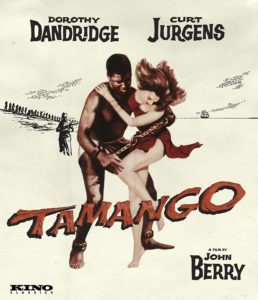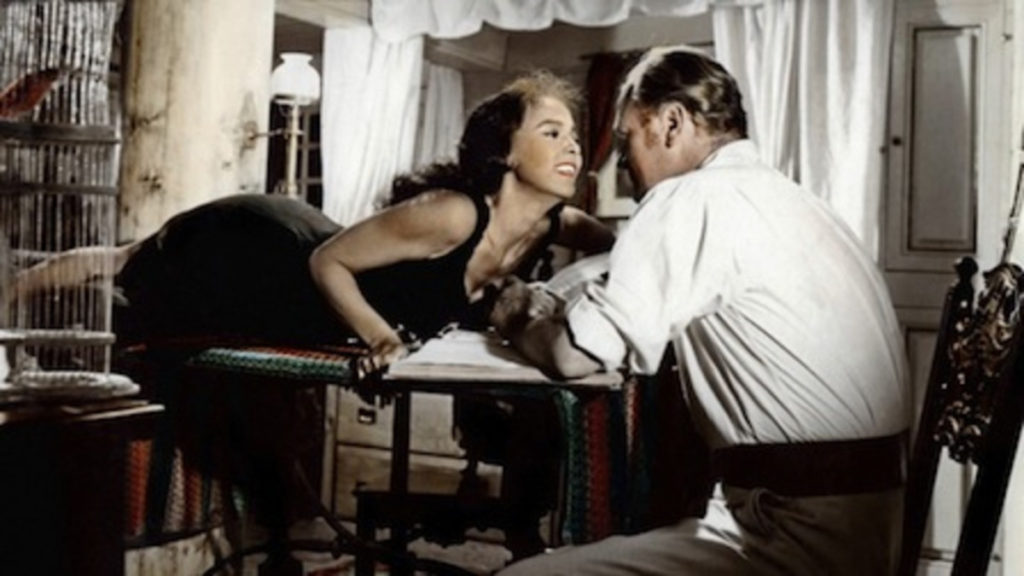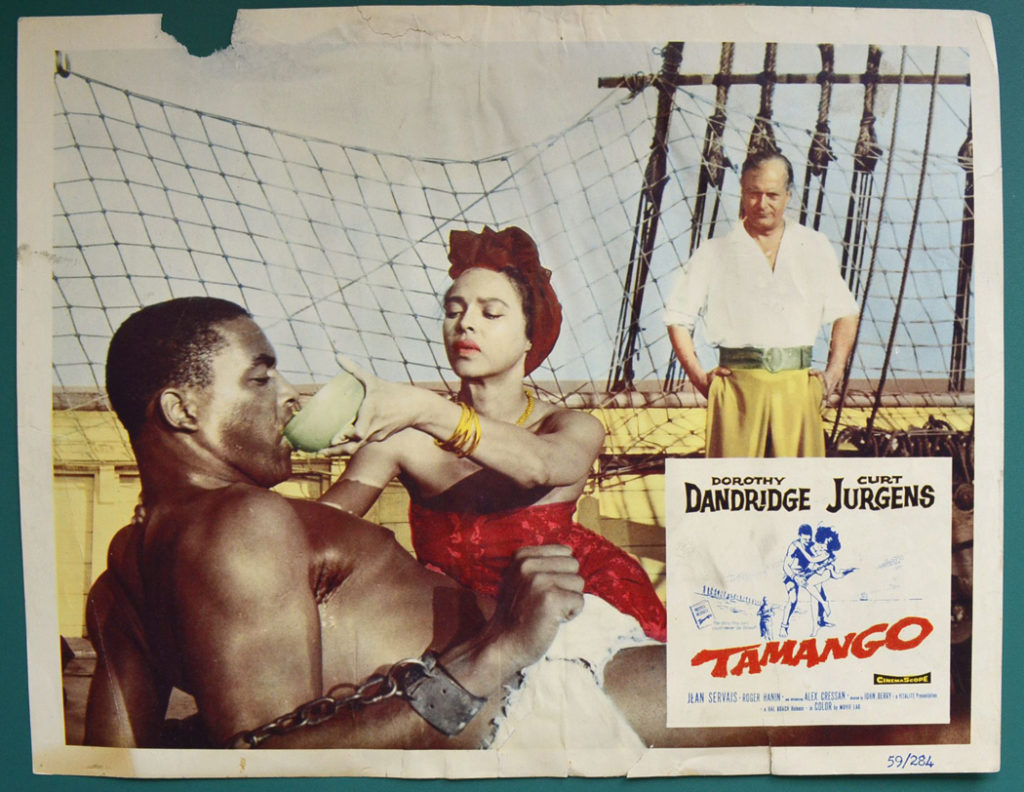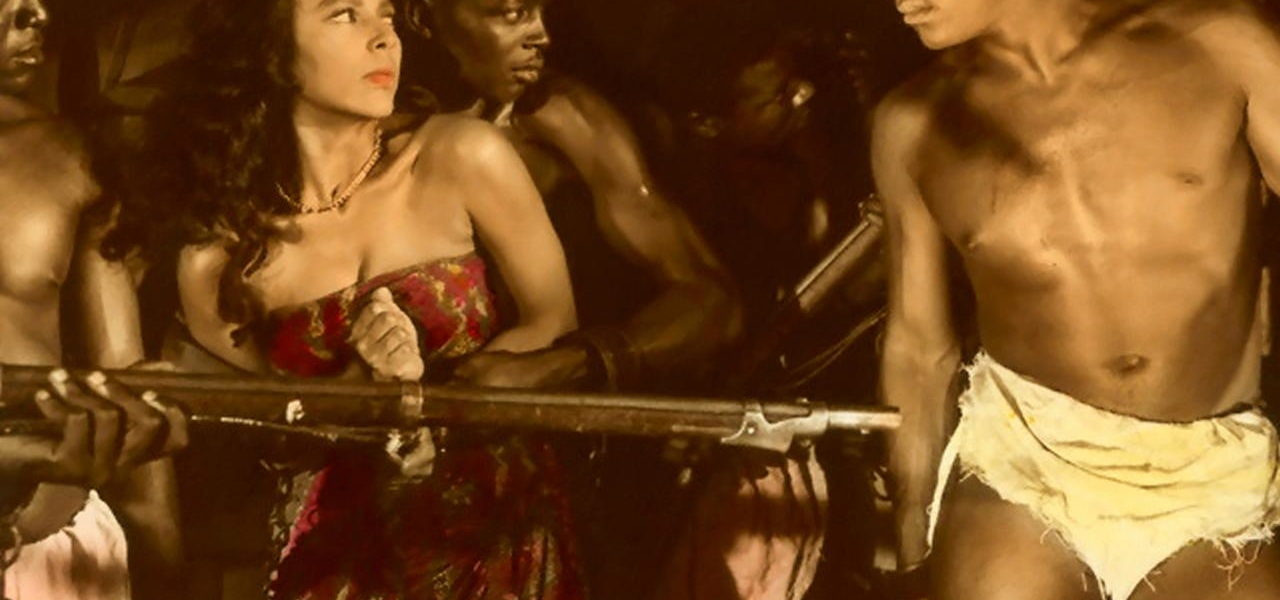Before There was Roots… Before There was Amistad… There was Tamango.
DIRECTED BY JOHN BERRY/1958
BLU-RAY STREET DATE: OCTOBER 22, 2019/KINO CLASSICS

In light of its own subject matter, it seems almost outlandish to declare the unknown status of director John Berry’s 1958 slave ship drama Tamango an injustice. But there it is. Set in 1820 and starring a particularly steely-eyed Curd Jürgens as the experienced captain of the outlaw slave ship the Esperanza and Dorothy Dandridge as his longtime servant girl, the film lands as an astonishingly forward-facing depiction of a great historical terror. For Jürgens’ character and his crew, wrangling Africans above deck and below and prodding them into maximum sellable condition is more or less just another day at the office.
From its stunning bright red opening titles splashing across its Cinemascope frame, Tamango confidently and competently presents itself as a film to be taken seriously. The fact that the title character (played with utter command by Alex Cressan) is the primary instigator and leader of the eventual slave revolt tells us something about the perspective of the film and its makers in terms of colonialism as well as true basic humanity. The film’s blacklisted director, John Berry (not to be confused with the differently spelled John Barrys, namely the prominent production designer and also the celebrated film composer), has made a kind of ground-zero “Black Lives Matter” statement with this film, some 62+ years ago. Clearly an off-the-radar non-Hollywood endeavor, the cynic in me is tempted to wonder if it’s overwhelming amount of sympathy for the slaves and the tremendous amount of screen time which they receive might’ve been a baseline contributor to the film’s obscure status.
Jürgens, tall and imposing in his beige safari jacket, demands the other half of the screen time. His character’s evil is meted out in doses, as looks into his far-gone soul and ultimate hubris. Jürgens is nothing short of excellent in the role, fully committed all the while. The actor demonstrates a firm understanding exactly what and whom he is playing. The viewer is likely to realize before the captain does that should he lose the upper hand with his precious human cargo, the only way out would have to be their complete eradication. It is the darkest of sick revelations in a situation right with sickness and darkness.

Yet, Tamango effectively demonstrates just how thin control of one man over another can be in the face of the inherent need for freedom. The getting of a metal hand file to the chained occupants of the below deck is everything; it’s spotting to its acquisition to its slow and steady usage to the eventual payoff spans a good bit of the films one hour and 40 minutes. It is expertly handled set up and pay off as well as, from a pure screenplay point of view, solid suspense. The film decidedly avoids the easy audience steering such as depictions of whippings and torture, although slaves are hanged and thrown overboard as gratuitous disciplinary warnings to make the points Berry needs made.
As for Dandridge- the first name on the poster which pits her trademark allure into some sort of physical struggle scenario that never happens on film- she is the wounded, conflicted soul of the film. She is a supporting character, but one much-needed. Unlike the Esperanza‘s current holding of newly captured prospective slaves, most of whom are described as mere farmers and weavers, not hunters or warriors, Dandridge’s character has lived a life in the tragic subjugation of white men. When we meet her, she’s long ago given up all hope, to the extent that she advises another forlorn female captive to “cry now and get it over with“, as “they’re not turning the ship around, they’re not ever taking us back to Africa.“ This is the beginning of their new normal. Yet, over time, thanks to the diligence of Tamango and his cohorts, she goes through a perspective shift that is essential in the audience’s processing of the viability of a proposed widespread uprising.
It’s tagline, stated on one of its posters, describes the film as “an adventure as bold and daring as the casting!“. “…as the casting!” … That part of the boast is certainly true enough of Western civilization in chronically backwards 1958. It is indeed bold and daring to make any kind of major motion picture led by so many black actors, particularly unknown unknown black actors. Most if not all of them would continue to be unknown after this film. Today of course, a film likeTamango would rightly court controversy were it to somehow go the opposite direction in terms of racial representation.

The disc’s only special feature is a not exactly well-rounded audio commentary by film critic Peter Tonguette. It’s a rather staid, sometimes sleepy affair, firmly locked in on cinematic matters as opposed to, say, much in the way of historical contextualization regarding its subject. Tonguette plainly tells us just about everything that there is to know about director Berry and breaks down his precise aesthetic, including his HUAC troubles, his proclivity for social justice, and his notable beginnings with Orson Welles’s Mercury Theatre Group. But viewers wondering how accurately Tamangodepicts the known realities of the then-outlawed (by France) slave trade will be disappointed. In this sense, the commentary, though greatly informative in its interests, seems oddly shortsighted.
The print utilized for this Kino Classics Blu-ray edition exhibits occasional damage, likely beyond the pale of repair. That relatively minor necessary observation aside, this disc boasts an outstanding presentation in terms of vigorous color and sound. Being an entirely ship-bound independent European production of the mid-1950s, as well as being one of bold social vision, it’s sadly unfortunate that Tamango has gone neglected to the point of disrepair. Thankfully, this release will serve as something of a corrective, as it showcases Berry’s film in all its possible glory.
Tamango is a great and profound discovery, and wonderful to have on Blu-ray. It reveals a filmmaker and his cast earnestly plugged into not only the gross realities of the historical slave trade, but also in a sense, the inequities faced by black people at the time of its making (and beyond). It also reveals that such thinking was shepherded to the screen before the cultural wake-up call of Roots, or even Steven Spielberg’s Amistad. The slave captives of the Esperanza are indeed “brothers in life, brothers in death” as they proclaim themselves to be. Tamango takes us right alongside of them.
The images and promotional material used in the review are present only as a reference to the film and are not meant to reflect the actual image quality or content of the Blu-ray.


